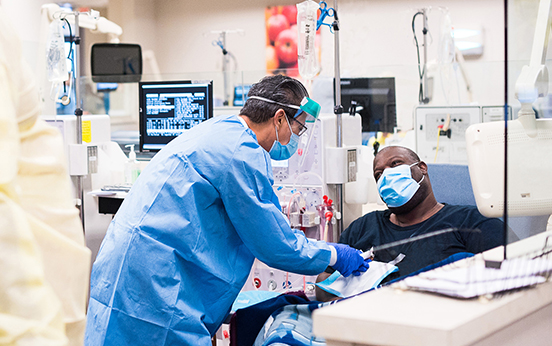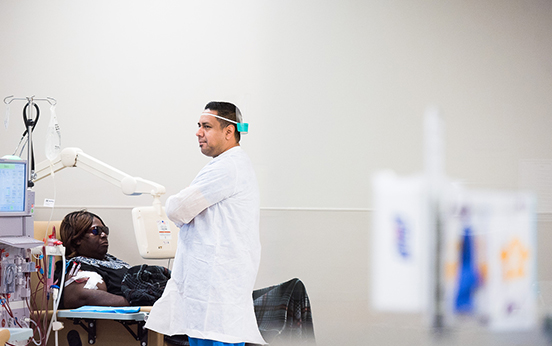- Find Center
- CH | EN
Although a healthy kidney in vivo has multiple functions, the most important function is to produce urine. When the kidney fails, it is unable to maintain your health by filtering blood and producing urine, which will lead to accumulation of toxin and excessive liquid in vivo. While dialysis is a kind of kidney replacement therapy, which can filter out metabolic waste in vivo, remove excessive liquid and balance electrolytes (sodium, potassium, bicarbonate, chloride, calcium, magnesium and phosphate).
Hemodialysis - use artificial filters in vitro to clean blood
Peritoneal dialysis (PD) - use natural filters in vivo to remove waste

Hemodialysis is a dialysis process in which blood is drawn from the body and then passed through an artificial filter (called a "dialyzer"). Dialyzer is the key to hemodialysis. It is called "artificial kidney", which undertakes the work of hemofiltration before kidney. The function of dialysate is to pull waste and liquid out of blood. As dialysate is washed away, waste will be discharged along with it. The average person's blood volume is between 4.73 and 5.67 liters. In the process of hemodialysis, only about 250 milliliters of blood is outside the body each time, and before that, a vascular access must be established to help blood flow from the body to the dialyzer and then return to the body.
At present There are three types of vascular access:
1.Arteriovenous fistula (AVF)
2.Arteriovenous graft (AVG)
3.Central venous catheter (CVC)
When chronic kidney disease develops to the end stage, dialysis is about to be carried out. Nephrologists will recommend that you establish an internal fistula or graft. Each access requires surgery. There are limited places where the human body can set up vascular access, such as arms, legs and neck. Internal fistulas and grafts are considered permanent access, because they are established under the skin, so they can generally be used for many years, while central venous catheter (CVC) is a temporary access that will need to be replaced by permanent access in the future. Venous fistula is currently the most recommended access type in dialysis, but your doctor will choose the most suitable access according to your physical condition.
When performing hemodialysis, the nurse or medical technician will test your vital signs and obtain weight data (the value of weight gain indicates the amount of excess liquid that must be removed during treatment), and then establish an access with the dialysis machine:
1.vascular access (arteriovenous fistula or arteriovenous graft) will have two connectors established in its access, one to take out blood from the body and the other to return blood to the body;
2.The central venous catheter (CVC) will have two catheters extending from their access. One of the two catheters is connected to the dialyzer, and the other is connected to the catheter that the dialyzer returns to the body, so the program on the dialyzer is set correspondingly, and then the treatment is started.
In fact, blood will never flow through the dialysis machine. The dialysis machine looks like a large computer and a water pump. It can record blood flow, blood pressure, removed liquid volume and other important information. The mixed dialysate flows into the liquid cavity of the dialyzer to remove toxin from the blood. The filtered dialysate is discharged into the sewage treatment center along with the pipe. The dialysis machine is equipped with a blood pump, which keeps the blood flow in the access during dialysis by pumping. And it contains multiple safety guarantees, which can assist nurses to take care of patients more thoughtfully and safely.
How many hours does the blood need to flow through the dialyzer to fully clean the blood and remove excess liquid from the body?
Hemodialysis needs to be carried out 3 times a week, and each treatment time needs to last 3-5 hours.

This is a kind of dialysis method without injection, which can be carried out according to your own plan at home and at work. Usually you needn’t the help of an assistant and this is the most common type of dialysis at home.
If you choose peritoneal dialysis (PD), your doctor will make a small incision in your abdomen and place a catheter (soft short tube) into your abdominal cavity.
The catheter consists of three parts: one part is placed in the abdominal cavity, the second part passes through the skin, and the last part extends out of the body. After the catheter is placed, it takes 2-3 weeks to heal the wound. When the catheter can be used, you will be required to attend a training course, in which you can learn how to operate safely by yourself.
In continuous ambulatory peritoneal dialysis (or CAPD), one end of the catheter will be connected to dialysate, and the dialysate containing excessive liquid and waste will be discharged and discarded, and then replaced with fresh dialysate. There are three stages of exchange: discharge, perfusion and retention. Usually, the discharge and perfusion stages in the exchange process take about 30 minutes, and the exchange takes 3-4 times a day. After the discharge and perfusion stages, the liquid will be retained in the abdominal cavity. During this stage, patients need not use the equipment and freely do what they want. Waste and liquid will be removed from the blood. Because this kind of treatment is done day and night, it can continuously remove waste and liquid like kidney. Keep in mind that a healthy kidney is not filtered only in its spare time, but work s24 hours a day, 7 days a week.
1.Patients can be cared for and treated by professional doctors and nurses in the hemodialysis center.
2.Patients can rest, read, write, watch TV, listen to music or do other quiet activities in the hemodialysis center.
3.There are four days a week when dialysis is not required.
Patients need to go to and from the hemodialysis center 3 times a week (to solve this problem, our hospital provides free daily shuttle service)
In addition, no matter what kind of treatment, it is necessary to adjust the dietary habits, including restricting the intake of food containing phosphorus, potassium and sodium, and restricting the amount of water consumed.
If you need diagnosis or treatment, or information about your specific situation, then you could have an online consultation with our doctor. Emergency calls are available for your reference.
This website is for reference only and does not replace the physician's medical advice.
Copyright 2012-2020 © Jinan Huishang Network Technology Co., Ltd. all rights reserved
Case Number: 鲁ICP备2020048429号-1